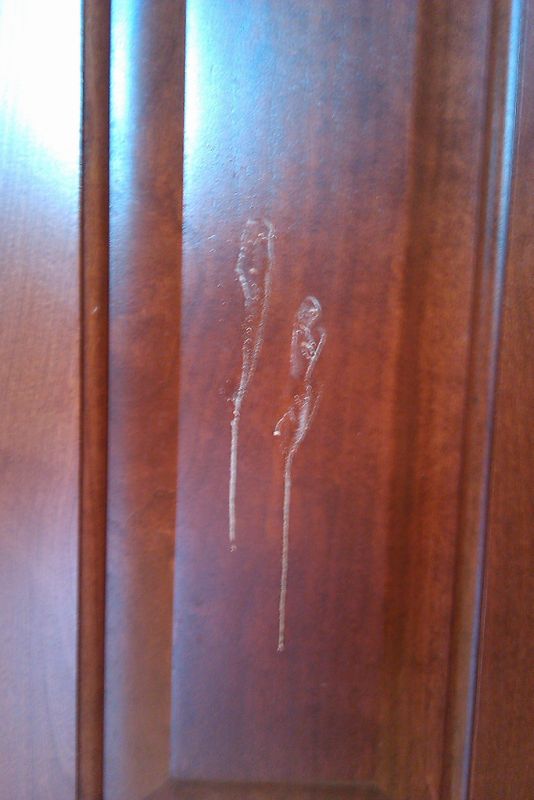Question
A client is having problems with the cherry trim in her house. It seems to me that someone has spilled something on a few of the cabinet doors, pantry door, baseboards and wainscoting. You can see in the not so great cell phone picture below. Whatever was spilled has etched into the lacquer. Does anyone know what could have done this? I am assuming the finish is a nitro lacquer. What is the easiest way to touch this up inside someone's home?

Forum Responses
(Finishing Forum)
From contributor G:
Based on the damage being in noncontiguous areas, Iím going to guess that it was deliberately done. How, why or with what is anybodyís guess.
Iíd start by wiping with a lacquer thinner-dampened rag and see if anything comes off. Depending on how it looks after that, Iíd suggest using a combo of razor blade, 400 grit sandpaper and lacquer thinner to level the surfaces.
After that, there are a number of Mohawk products that will be useful, including their Ultra Flo Ultra Bond clear topcoats, which are formulated to repair difficult to coat surfaces, such as UV finishes and two-component polyurethanes.
Now use a high solids sanding sealer and hair dryer, set to low heat and high air flow to build the fill to the level of the surrounding finish. Careful - you must let it flash then cure with the gun or it will blush. You now have something that is thick and fragile until cured. It's nice to have multiple things to work on because you now need to sand all that sealer back to the level of the surrounding finish. So while the heat gun can cook the finish all the way to the bottom, it will still be tender while it's warm.
With the correct sheen, spray the entire taped off raised panel. Your fill must be flat, your color correct, and your sheen must match, or the repair will stand out!
If you're lucky, and you're careful to remove the blistering finish, you might get away with wet sanding and a few topcoats over the entire door. If the damage has affected the color along with the finish, your touchup skills are going to be the determining factor in how it looks when you're finished.
You could experiment with your color matching on the back of a drawer front. Looks like some burnt sienna could play into the color match... maybe a bit of Van Dyke brown or raw umber.
I did a kitchen in MLC MagnaMax and the tile guy had a problem with a haze on his tile. He came back several times to wipe down his tile and was unsuccessful removing the haze. He came back one last time and used a strong acid on the tile and it worked. Several days later the panel sides of my cabinets started to get white haze spots on them. Had to get the sides refinished. Months later the hazing started to creep back. So whatever it was, it was pretty strong. Maybe 10% muriatic acid.